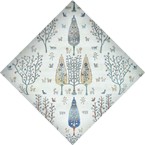Senneh (Sanandaj) is a Persian tribal rug hand-woven by Kurdish semi-nomads of the Senneh district, which sits in the heart of Kurdistan, in Northwestern Iran. Most of the Sennehs made are better in quality than most of the rugs produced in some of the surrounding villages. The city of Senneh often produces a design very similar to the Bidjar. The city of Bidjar is very close to Senneh and the two share a long history of rug weaving together. They usually have the famous Herati (Mahi) design. There is usually a diamond medallion embedded within another. A rug of this type will significantly enhance any dining or living room. This is a one of a kind hand made tribal rug that will look beautiful for many years to come.
Kurdish carpets are woven throughout western Iran, in and around the rugged mountainous region of Kurdistan. The Kurds derive from the ancient nomadic peoples that roamed the area thousands of years ago. They live a semi-nomadic life, either in villages or in moving tribes away from the cities, where they can still carry out their old traditions and live as they did thousands of years ago. A few of the Kurdish tribes of the western regions include the Herki, Senjabi, Gurani, Jaffid, and Kalhors. A few major Kurdish rug-producing centers are Senneh, Bidjar, and the district of Khamseh. Some other Kurdish villages and districts that produce rugs are Borchelu, Goltogh, Khoi, Koliai, Lylyan, Mousel, Nanadj, Songhore, Touserkan, and Zagheh. As you can see, the Kurds are well established, and historic semi-nomadic and/or nomadic peoples of Iran who date back thousands of years. Many other major rug producing centers of Iran, such as Hamadan, Lorestan, or even Arak show obvious traces of Kurdish influence. Sometimes they incorporate the style and techniques of the Turkish people of Iran, who are also very widespread. The Kurds are a very peaceful and gentle group who prefer their simple nomadic lives to the complexities and frustrations of the modern technological world.
kurdish rugs, like all other Persian rugs are all 100% handmade. They are made of pure wool which is spun from the weaver's own sheep. In very rare cases you might find a carpet that has silk in the pile, and you will often see the foundation of Kurdish rugs being made of goat hair. The pile however, is always wool. The weaving quality in Kurdish rugs varies from loose to dense knotting and the Persian asymmetrical knot is used more than the Turkish symmetrical knot. The colors are attained mainly from natural vegetable dyes. The color schemes of most Kurdish rugs are bright and vibrant. Unlike most people in the western world who like faded and muted colors, the Kurds love bright lively colors. These exciting rugs bring life to these simple people's dull homes. All Kurdish rugs are rugged and long lasting as they have proved to be for thousands of years.
(6'6" x 10'2") Persian Sanandaj
SKU 100-11093
(8'6" x 11'6") Persian Sanandaj
SKU 100-14926
(8'5" x 11'3") Persian Sanandaj
SKU 100-10771
(8'0" x 12'2") Persian Sanandaj
SKU 100-75382
(2'9" x 13'3") Persian Sanandaj
SKU 100-21798
(6'7" x 9'11") Persian Sanandaj
SKU 100-11696
(5'5" x 7'4") Persian Sanandaj
SKU 100-22501
(2'11" x 8'4") Persian Sanandaj
SKU 250-24370
(2'4" x 9'11") Persian Sanandaj
SKU 250-22677
(6'9" x 9'6") Persian Sanandaj
SKU 251-13859
(3'1" x 12'6") Persian Sanandaj
SKU 250-22799



Be the first to know about new designs and
exclusive offers, and get up to
10% OFF
your first purchase

Rugman.com since 1998 | The first and oldest online rug store
You can unsubscribe with a single click. We value your privacy; click here for more info.

You have one more step to join
Rugman Insider Club.
A coupon code will be emailed to you.
Please check your email and just
click the green “Confirm Subscription” button.

